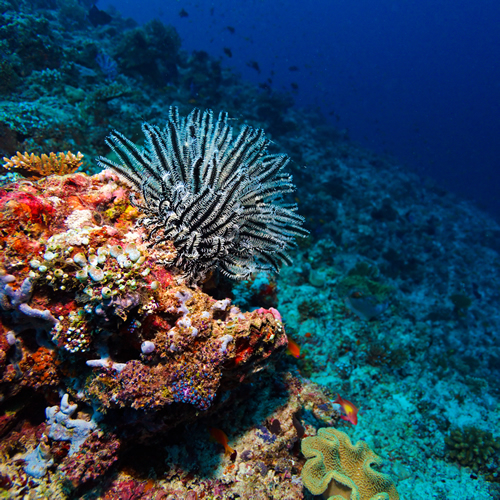How will ocean acidification impact marine life?

Coral is one of the key species threatened by ocean acidification. © Rostislav Ageev | Dreamstime.com
Many marine organisms—such as coral, clams, mussels, sea urchins, barnacles, and certain microscopic plankton—rely on equilibrated chemical conditions and pH levels in the ocean to build their calcium-based shells and other structures. A new analysis published in the journal Environmental Science and Technology provides a holistic analysis of how species will be affected worldwide under different climate scenarios.
“Calcifying species are indispensable for ecosystems worldwide: they provide nursery habitats for fish, food for marine predators, and natural defenses for storms and erosion. These species are also particularly vulnerable to ocean acidification triggered by increased fossil fuel emissions,” says IIASA researcher Ligia Azevedo, who led the study.
Just as carbonated soda water is more acidic than flat tap water, higher levels of carbon dioxide (CO2) in the ocean cause the water to become more acidic. And high acidity makes it more difficult for calcifying species to make their calcium structures such as shells, reefs, and exoskeletons.
“Previous studies have shown that marine species were being negatively affected by decreasing ocean pH levels. But until now most studies looked at individual species. This study is one of the first to analyze the impact on the whole community of calcifying species, while also looking at both pH levels and CO2 partial pressure,” says Azevedo.
The study examines the impact of increased ocean acidity on species growth, reproduction, and survival. It used two climate change scenarios from the Intergovernmental Panel on Climate Change (IPCC) Fifth Assessment Report (AR5): In the low emissions scenario, ocean pH is projected to decrease from 8.1 to 7.95, while in the high emissions scenario, median ocean pH is expected to decrease to 7.80. (Lower pH indicates higher acidity).
The analysis finds that under the high emissions scenario, between 21-32% of calcifying species would be significantly affected, based on a threshold of 10% of a species population being affected. In the low emissions scenario, only 7-12% of species would be affected.
Azevedo notes that while the study is an important new milestone for ocean acidification research, it does not show what level of impact which species population can handle, that is, how much acidification is too much.
“It’s hard to say what the level of impact would mean for different organisms – a 10% rate could be no problem for some species, but for other more sensitive species it could mean one step closer to local extinction,” explains Azevedo.
The study also emphasizes that much uncertainty remains about the level of acidification that would lead to major impacts on calcifying species – in part because of varying experimental results.
The researchers say that the analysis is an important step forward to provide policymakers a better understanding of the big picture of climate impacts on the ocean.
Azevedo says, “The main benefit of this study is to provide a new research framework that policymakers could use for climate policy planning, life cycle impact assessment, and environmental risk assessment.”
The study was funded in part by a grant from the European Research Council to explore the balance of carbon, phosphorus, and nitrogen in the environment.
Reference
Azevedo LB, Schryver AD, Hendriks AJ, and Huijbregts MAJ. 2015. Calcifying Species Sensitivity Distributions For Ocean Acidification. Environmental Science and Technology. doi:10.1021/es505485m http://pubs.acs.org/doi/full/10.1021/es505485m (Open Access)
Contacts
Ligia Azevedo
IIASA Ecosystems Services and Management Program
Tel: +43(0) 2236 807 550
azevedol@iiasa.ac.at
Katherine Leitzell
IIASA Press Office
Tel: +43 2236 807 316
Mob: +43 676 83 807 316
leitzell@iiasa.ac.at
About IIASA:
IIASA is an international scientific institute that conducts research into the critical issues of global environmental, economic, technological, and social change that we face in the twenty-first century. Our findings provide valuable options to policy makers to shape the future of our changing world. IIASA is independent and funded by scientific institutions in Africa, the Americas, Asia, Oceania, and Europe. www.iiasa.ac.at
Media Contact
All latest news from the category: Ecology, The Environment and Conservation
This complex theme deals primarily with interactions between organisms and the environmental factors that impact them, but to a greater extent between individual inanimate environmental factors.
innovations-report offers informative reports and articles on topics such as climate protection, landscape conservation, ecological systems, wildlife and nature parks and ecosystem efficiency and balance.
Newest articles

A ‘language’ for ML models to predict nanopore properties
A large number of 2D materials like graphene can have nanopores – small holes formed by missing atoms through which foreign substances can pass. The properties of these nanopores dictate many…

Clinically validated, wearable ultrasound patch
… for continuous blood pressure monitoring. A team of researchers at the University of California San Diego has developed a new and improved wearable ultrasound patch for continuous and noninvasive…

A new puzzle piece for string theory research
Dr. Ksenia Fedosova from the Cluster of Excellence Mathematics Münster, along with an international research team, has proven a conjecture in string theory that physicists had proposed regarding certain equations….



